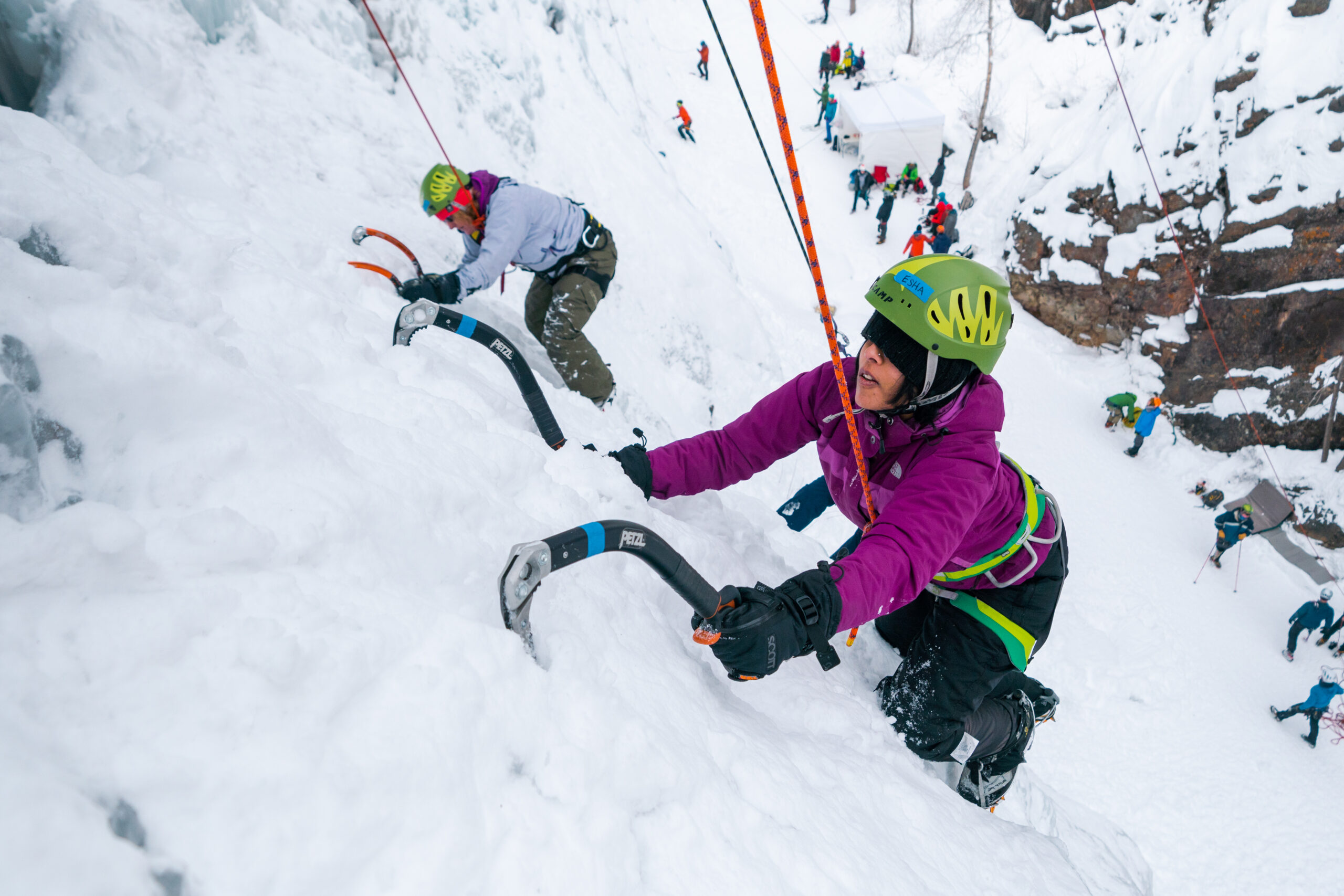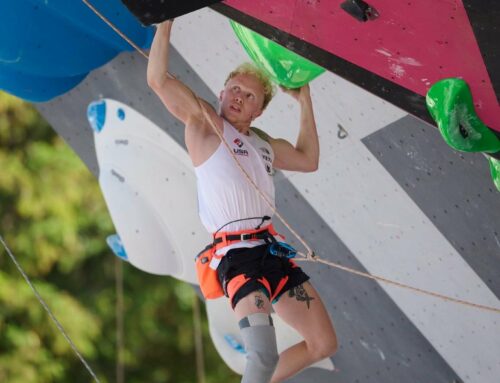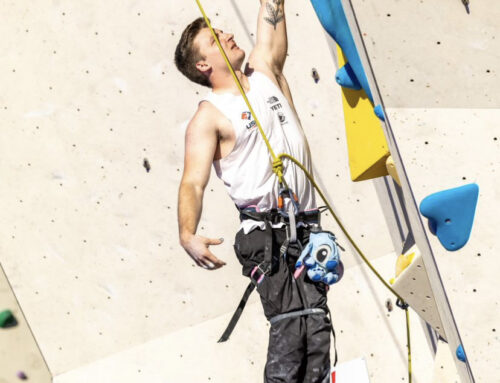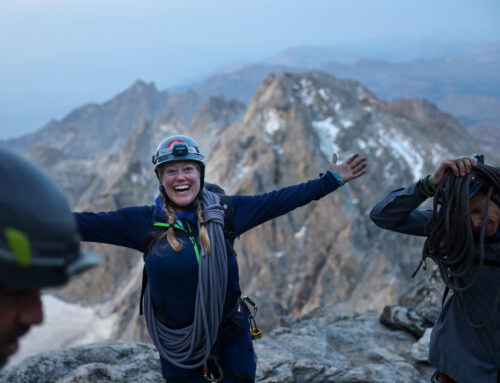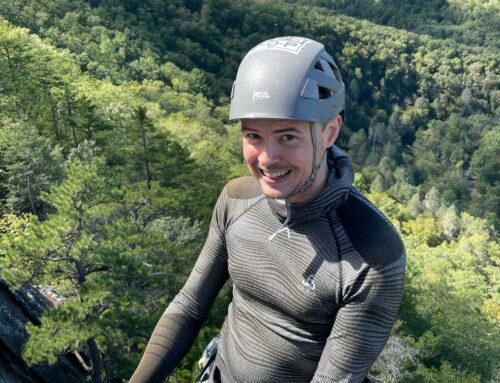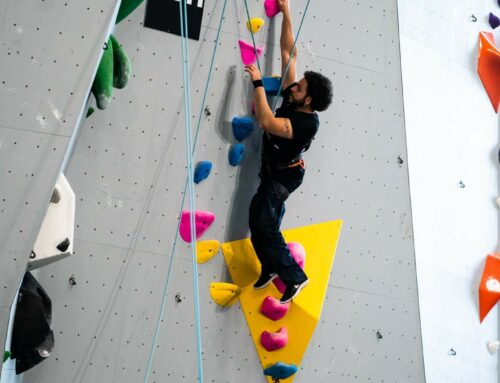Meet Paradox Sports Ambassador, Esha Mehta!
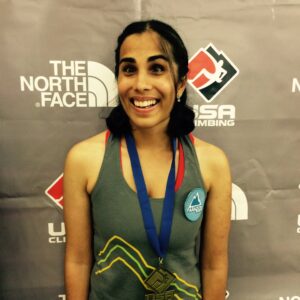 Tell us about yourself:
Tell us about yourself:
Hi! I am Esha and I recently graduated from the University of Denver back in June of 2021. Right now, I work as a therapist at Eating Recovery Center -Pathlight Mood & Anxiety Center. I’ve been climbing with Paradox since 2015. I got introduced to Paradox through a friend. I was in a running group called Achilles for a while and told one of the guides that I wanted to get back into rock climbing and he introduced me to Paradox. I went to one of the club nights and completely fell in love with climbing all over again. I had started climbing back in 2009 when I first moved to Colorado, but I didn’t really climb from the time I started school in 2010 until about 2015. Anyway, in 2015, I got in touch with Paradox, went to a club night, and completely fell in love. I met Mo and she convinced me to compete. So, I caught that bug maybe two or three months after I started climbing with Paradox. That was when Nationals happened and that was my first Nationals. So that was really fun. I’ve been climbing since then, I’ve done a lot of different Paradox trips since then like Shelf Road, a lot of trips in Eldorado Canyon when I lived in Boulder, and a Ouray Ice Climbing trip. I haven’t competed since before the pandemic because well, pandemic ha-ha. I competed in 2018 and 2019. 2018 was when I went to Innsbruck in Austria for Worlds. That was my first time for Worlds which was amazing and such an awesome experience. The next time I went was when it was in Briançon, France. It was probably one of the highlights of my life because I topped one of the comp routes and that never happened, so it was really cool! It was such an amazing experience. Everyone on the team and even the people that we were competing against were so supportive and excited to see paraclimbers.
When I’m not climbing I do musical theater with Phamaly Theatre Company in Denver. We just finished a show at the beginning of this month and we did the Rocky Horror Show. It was amazing- it was so much fun! I love doing theater in the off season. It’s great because it combines my other loves of singing, acting, and dancing.
I also have a guide dog named Dragon, he’s the love of my life.
What got you involved with climbing? What keeps you coming back to the sport?
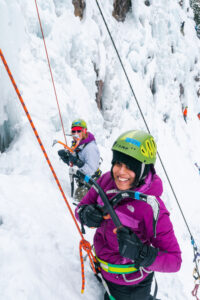 I moved out to Colorado in 2009 to go to the Colorado Center for the blind to learn independent living skills and things like that. During our program at CCB we would do activities that were called ‘challenge recreation’, which were confidence building activities. The idea behind it is that if you can climb a mountain with a blindfold, chopping a tomato under one is super small fries. I have some usable vision in my right eye; and, at the Center, if you have any usable vision at all, you are blindfolded so that you can build confidence in your blindness skills without relying on whatever vision you have left. So, that’s initially how I started climbing. I climbed with them and the National Sports Center for the Disabled who would take the CCB students rock climbing. That was my first introduction with outdoor climbing and I loved it so much, I went on all of those trips. Unfortunately, because of school and getting very sick with a restrictive eating disorder, I couldn’t climb due to my mental and physical health. In 2017, I found my way back to climbing. I realized how much of a grounding activity climbing was for me. I have a dissociative disorder due to a lot of trauma that I went through as a kid and dissociate regularly; but, I found that when I’m climbing and belaying, I am totally present in that moment. So, for me, climbing is like another form of therapy. Especially when you’re belaying, your mind can’t be in 5 other places. For me, I have a lot of flashbacks and things like that because of my complex PTSD and when I’m belaying and climbing I don’t really have a lot of symptoms, which is just amazing to me. It’s definitely been a gift. As a therapist, I recommend climbing to a lot of my clients as a way to gently get back into their bodies and do something that is A., fun, and B., very mindful. I tell everybody about climbing, I’m like “Hey! You’re feeling ungrounded? Have you tried rock climbing?!”
I moved out to Colorado in 2009 to go to the Colorado Center for the blind to learn independent living skills and things like that. During our program at CCB we would do activities that were called ‘challenge recreation’, which were confidence building activities. The idea behind it is that if you can climb a mountain with a blindfold, chopping a tomato under one is super small fries. I have some usable vision in my right eye; and, at the Center, if you have any usable vision at all, you are blindfolded so that you can build confidence in your blindness skills without relying on whatever vision you have left. So, that’s initially how I started climbing. I climbed with them and the National Sports Center for the Disabled who would take the CCB students rock climbing. That was my first introduction with outdoor climbing and I loved it so much, I went on all of those trips. Unfortunately, because of school and getting very sick with a restrictive eating disorder, I couldn’t climb due to my mental and physical health. In 2017, I found my way back to climbing. I realized how much of a grounding activity climbing was for me. I have a dissociative disorder due to a lot of trauma that I went through as a kid and dissociate regularly; but, I found that when I’m climbing and belaying, I am totally present in that moment. So, for me, climbing is like another form of therapy. Especially when you’re belaying, your mind can’t be in 5 other places. For me, I have a lot of flashbacks and things like that because of my complex PTSD and when I’m belaying and climbing I don’t really have a lot of symptoms, which is just amazing to me. It’s definitely been a gift. As a therapist, I recommend climbing to a lot of my clients as a way to gently get back into their bodies and do something that is A., fun, and B., very mindful. I tell everybody about climbing, I’m like “Hey! You’re feeling ungrounded? Have you tried rock climbing?!”
Can you share a little bit more about what climbing looks like for you? For example, do you use a caller, side climber, etc.
If I’m training for competitions, I will use a caller because with competitions, it’s more efficient and easier to have a caller. But, if I’m climbing for fun, I will do what I call a “rainbow climb”, where whatever I touch, I just go with it. I am in the market for a caller, so if anyone out there wants to be a caller let me know!
Do you have any tips or advice for someone who is calling holds for yourself or other VI climbers?
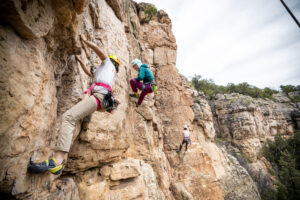 Yeah, so many tips! I’ll stick with a few though because I could go on for hours. I guess my number one tip is that if you’re a caller and working with someone who’s VI, really learn to adopt their language and ask questions. Ask your partner questions about what’s helpful to them, because each climber is slightly different in how they like to have their caller relay information. So, for myself, I really like using the clock system for my hands. As far as distance, I like to use far, medium and close. For my feet, I like using parts of the body, so something like, “Inside your left hip”, “Outside your left hip”, “By your left knee”, and “By your right knee.” It’s not a universal thing, so it’s super important for callers to ask questions, number one, and number two, it’s important to adopt the language that your partner is using. If you can come up with a communication between the two of you, it can be super helpful. That’s what my last caller and I did, we developed our own language and it worked super well. The third thing is, which is really hard, especially for new callers, is being very succinct and clear. You can’t say something like, “Oh, well there’s this hold that’s a ways away at like 11 o’clock from your right hand. It’s kind of far, looks like a jug but I’m not sure.” You have to be more like, “Jug at 11 o’clock, right hand, far.” Because, when we’re on the wall, especially during competitions, we’re using so much of our endurance just to stay on the wall, waiting for the next instruction. So, the more efficient you can be with your communication the better. It takes a lot of practice with your partner but the more you can dial that in, the more successful you two will be!
Yeah, so many tips! I’ll stick with a few though because I could go on for hours. I guess my number one tip is that if you’re a caller and working with someone who’s VI, really learn to adopt their language and ask questions. Ask your partner questions about what’s helpful to them, because each climber is slightly different in how they like to have their caller relay information. So, for myself, I really like using the clock system for my hands. As far as distance, I like to use far, medium and close. For my feet, I like using parts of the body, so something like, “Inside your left hip”, “Outside your left hip”, “By your left knee”, and “By your right knee.” It’s not a universal thing, so it’s super important for callers to ask questions, number one, and number two, it’s important to adopt the language that your partner is using. If you can come up with a communication between the two of you, it can be super helpful. That’s what my last caller and I did, we developed our own language and it worked super well. The third thing is, which is really hard, especially for new callers, is being very succinct and clear. You can’t say something like, “Oh, well there’s this hold that’s a ways away at like 11 o’clock from your right hand. It’s kind of far, looks like a jug but I’m not sure.” You have to be more like, “Jug at 11 o’clock, right hand, far.” Because, when we’re on the wall, especially during competitions, we’re using so much of our endurance just to stay on the wall, waiting for the next instruction. So, the more efficient you can be with your communication the better. It takes a lot of practice with your partner but the more you can dial that in, the more successful you two will be!
Sometimes, when I’m climbing with a new caller, whether it’s competition or just for fun, they know that I’m getting tired when I just take off my head set and start scanning around because I’m super pumped. It can feel like I will fall off if I don’t get any beta in the next 2 seconds. It feels like a dance with your caller and with you as the climber. It’s definitely a team thing and you have to have good chemistry, you have to know each other’s language, and finally, I also think it’s helpful if your caller is around the same height as you. What’s far for them could be really unreachable for me because I’m not very tall and what’s close for them could be far for me. So, if it’s possible to have a caller who’s around your same height, that can be helpful as well. It doesn’t necessarily have to be that way though. My last caller, who was significantly taller than me, understood what my distance measurements were so she was able to translate that well because of climbing together a bunch and practicing. Again, that communication is so critical.
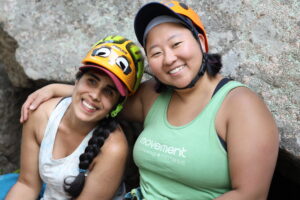 Do you prefer indoor or outdoor climbing?
Do you prefer indoor or outdoor climbing?
Outdoor! Hands down outdoor climbing! Oh my gosh, I love outdoor climbing, and the reason why I love it so much is because, unlike indoor climbing, where there are different routes that you have to follow, with outdoor climbing anything is fair game. I feel like outdoor climbing is made for blind and VI climbers because it’s about what you’re feeling around you. When you scan for the next hold, it’s not necessarily about following a set route or different colors. Whatever is touched is fair game, and going back to that mindfulness piece, it’s about feeling the rock face, the different textures, the occasional bird’s nest, or even a tree! Ha-ha! All of those things really keep you in the present moment. I just feel like climbing is a sport that is made for VI climbers!
With outdoor climbing, what I’m really into is crack climbing and climbing chimneys! Chimneys are like my favorite thing in the world right now which is kind of bizarre, but I’m super bendy so the weirder and the more bizarre the move is, the more fun it is for me because I can get all twisted into a pretzel. I also enjoy your regular outdoor, friendly neighborhood cliff–all of it! I’m also re-learning how to lead climb right now which is super fun! My roommate, Bill, who’s also blind, and I climb together a lot. He’s been reteaching me how to lead. I used to lead, but then I got sick and my brain got spicy and I lost all of those memories, so I’m relearning how to lead climb and am loving it so much. it’s so cool!
What I love about it is that, going back to the therapeutic bit, is that it really forces you to develop your effective communication skills. I work with a lot of folks who struggle with their effective communication, and again, recommend trying lead climbing, and top rope too, as a way to develop that essential life skill. I love to share with people that in climbing, you really have to know how to communicate with your climbing partner. For lead climbing, especially when you’re VI, you really have to have solid communication with your climbing partner, especially while clipping or when you reach the anchors. Some gyms are really nervous about letting VI climbers lead climb because they don’t have the education about how blind people do it. What I like to educate gyms about is that any VI climber can lead climb, it’s just about really developing that solid communication and, like with anyone, being at the appropriate skill level as a climber.
Do you have any upcoming climbing trips or objectives?
I haven’t been to Nationals in a hot second and that has been so sad, so my number one goal is to get back to Nationals. I would need a caller for that, so here’s my second shameless plug for that! Ha-ha! But yeah, a goal is to definitely go to Nationals this year and I would also be over the moon if my caller and I earn a spot on the USA Adaptive team again. That would be amazing! I think Worlds is in either Switzerland or Sweden this year. I know Paradox is doing a couple end of the season outdoor trips too, so I’m going to try and join those! It’s been so long since I’ve seen my climbing family!
In the beginning of the summer, I was climbing a lot more, but then, because of the show I was in, I was in rehearsals almost every day until around 10:30 PM, So I haven’t really been climbing in a hot minute and I am very much looking forward to getting back on the wall.
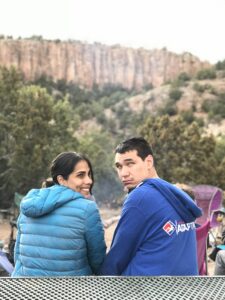 Are you involved with any other adaptive organizations?
Are you involved with any other adaptive organizations?
I’ll put in a plug for Phamaly Theatre Company. They are a world renowned, disability affirming theater company for people with disabilities of all kinds. All disabilities are welcome and there’s no such thing as “You aren’t disabled enough.” We put on professional shows and it’s amazing. It’s like another family as well. If you have any desire to be on stage or want to act and develop your skills and get creative with some amazing people, come audition for Phamaly!
Where would you like to see adaptive climbing go in the future?
I’m really excited for gyms to become more aware of adaptive climbers and breaking that barrier of what able bodied people’s understanding of what people with disabilities can do. That’s my big mission. I want people to know that just because a person may have mental health disorders and/or is blind doesn’t mean that they can’t climb. And, for myself, the more they say no the more I’m going to try to prove them wrong and do it anyway!
I think a good place to start for gyms wanting to be more involved with paraclimbing is having adaptive climbing nights and doing club nights. I also think encouraging ‘belaytionships’ for people who are looking for callers or belayers would also be great. Just getting the word out there that adaptive climbing is a thing is so important. I think that a lot of people still don’t realize that it’s possible for people with disabilities to climb. Visibility is the key, in my opinion. What I also love to do is speaking engagements with different gyms. I haven’t done one in a while, but I love meeting staff at gyms and talking to them about my journey as a climber and my experience of the cross-sectionality of being VI and having mental health disorders. Climbing is for everyone, in my opinion, and the more you invite people into the world of paraclimbing, the more awareness adaptive climbing is going to get.
Photo Descriptions:
Photo 1: Esha ice climbing in the Ouray Ice Park. She is wearing a purple jacket and green helmet. She has both ice axes in the ice and is looking up towards the top of the climb. There is another climber to her right. Photo by Will Strathmann.
Photo 2: Esha smiling at the camera at the 2015 Paranationals. She is standing in front of a backdrop that has the USA Climbing and North Face logo on it. Her grey tanktop has a Paradox Sports patch on it.
Photo 3: Another photo of Esha climbing in the Ouray Ice Park. She is looking at the camera smiling and posing with her ice axes in an X. Photo by Will Strathmann.
Photo 4: Esha midmove on a rock climb in Shelf Road. She has her feet spread wide and her hands closer together. A caller is side climbing with her and is on her right side. The rocks are reddish brown and there are trees off in the distance. Photo by Will Strathmann.
Photo 5: Esha and Jess sitting and smiling at the camera in Staunton State Park. They are both looking at the camera and wearing helmets and tanktops. Jess has her arm around Esha. They are right in front of a grey rock face.
Photo 6: Esha and Bill sitting at a picnic table at the campsite in Shelf Road. Their backs are facing the camera but they are turned and smiling at the camera. In the background, off in the distance, you can see the rock walls of Shelf and many trees.


